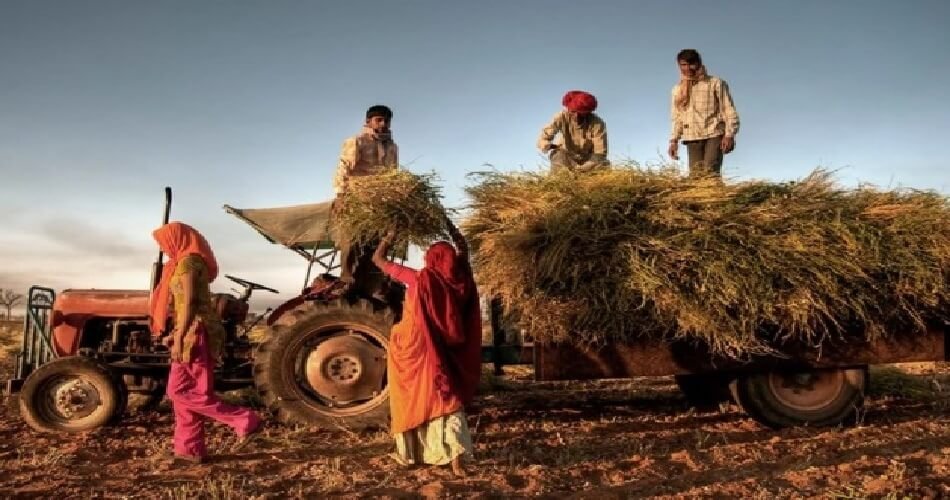Indian Agri sector grew at11% CAGR between 2015-2020 – CII & Bain Report
According to a report on ‘Innovation in India’s Rural Economy’ prepared jointly by the Confederation of Indian Industry (CII) and Bain and Company, the agriculture sector grew at an 11 percent CAGR between 2015 and 2020, with the sector experiencing the most disruption in terms of smartphone and internet penetration.
Agriculture is the most important sub-sector of the rural economy, accounting for about 37% of total rural GDP in 2019-20. According to research by Parijat Jain, a partner at Bain and Company, its contribution to the nation’s GDP was ₹35 lakh crore.
Also Read | Improving effectiveness of agri credit to catalyse growth in agri sector
In 2019-20, rice and wheat accounted for 40% of the land under cultivation in the country, with proteins, fat, fruits, and vegetables accounting for the remainder.
It said that the Indian rural sector is big and continually rising and that the rural economy generated about half of the country’s entire GDP in 2019-20. Furthermore, it employed 350 million individuals, accounting for 68% of the entire workforce.
10% increase in Agri credit
‘Over the previous five years, the rural sector has risen at a 10% annual rate and still has a tremendous capacity for expansion,’ the study stated, adding that there has also been a large increase in rural credit access.
Agriculture credit has increased by 10% in the previous five years, from ₹ 8 lakh crore in 2014-15 to ₹14 lakh crore in 2019-20. Rural microfinance total loan portfolios increased as well, going from ₹1,32,900 crore in March 2020 to ₹1,46,700 crore in March 2021.
Credit demand has surged, particularly for consumption-driven loan products such as those for two-wheelers and consumer durables. Technology disruption aided this rise by cutting loan servicing costs, allowing lenders to service lower-value loans.
All of this has resulted in the expansion of agtech start-ups, which have garnered a total of ₹6,600 crore in private equity investments between 2017 and 2020. ‘As younger generations of farmers and FPOs gain digital literacy, new business models are emerging throughout the agriculture value chain, from inputs and harvesting to processing and distribution,’ according to the paper.
Initiatives of the Centre
The Centre’s policies, such as the adoption of a Model Contract Farming Act in 2018 and the approval of projects by commercial and non-profit organizations, have aided in the formation and development of farmer producer organizations (FPOs), it said.
‘FPOs are becoming important entry points for farmers, and they may raise awareness and encourage new projects.’ ‘These developments have created a favorable environment for innovation, allowing both start-ups and established incumbents to propose innovative business models that address inefficiencies in the industry,’ Jain said in the paper.
Initiatives to improve information and openness are tackling current inefficiencies and formalizing a previously informal economy. ‘For example, Ninjacart, a supply-chain platform, created an online marketplace to link farmers and merchants directly without the need of intermediaries. It promotes farmer engagement by providing price, demand insight, and payment security. Another example is Indigo Ag. Its platform provides services across the agriculture value chain, such as agronomy consulting, quality testing to boost yields, and a marketplace to link buyers and sellers,’ according to the study.
Expanding Digital Infrastructural
More rural and agricultural-focused players, such as Jai Kisan and Samunnati, are connecting farmers to financial partners, expanding awareness and access to lending choices. Furthermore, government initiatives like as the Agriculture Infrastructure Fund and the Pradhan Mantri MUDRA Yojana (PMMY) provide low-interest loans to farmers and FPOs, as well as non-corporate, non-farm, small, and micro companies, in order to promote financial inclusion.
Physical infrastructure and connections have also improved, while digital infrastructure has advanced significantly. According to the survey, rural smartphone and internet penetration has climbed by 30% each year over the previous five years, with Covid-19 accelerating smartphone exposure and proficiency since many schools switched to online classrooms during the pandemic.
Aadhaar identity numbers have been provided to around 1.3 billion Indian people as of March 2021. This has also expedited digital payments and banking developments, increasing citizens’ access to cash and credit.
Also Read | Centre to link six online agri portals with eNAM to increase trading volumes
‘While cash remains the most popular means of payment in rural India, Unified Payments Interface (UPI) transactions have more than quadrupled in the last year. Several reasons contributed to the rapid increase, including Aadhaar’s creation of a digital identity, which allowed services like as Know Your Customer (KYC) and e-sign,’ according to the research.
It further stated that the Pradhan Mantri Jan Dhan Yojana (PMJDY), which is part of the National Mission on Financial Inclusion, has resulted in the opening of nearly 40 crore bank accounts by 2021.


















Add Comment